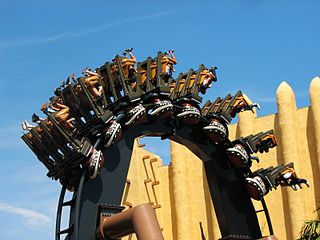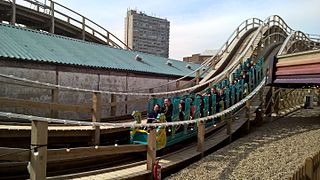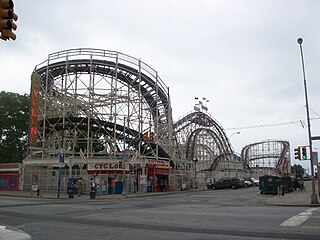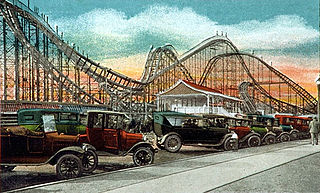
A roller coaster is a type of amusement ride that employs a form of elevated railroad track designed with tight turns, steep slopes, and sometimes inversions. People ride along the track in open cars, and the rides are often found in amusement parks and theme parks around the world. LaMarcus Adna Thompson obtained one of the first known patents for a roller coaster design in 1885, related to the Switchback Railway that opened a year earlier at Coney Island. The track in a coaster design does not necessarily have to be a complete circuit, as shuttle roller coasters demonstrate. Most roller coasters have multiple cars in which passengers sit and are restrained. Two or more cars hooked together are called a train. Some roller coasters, notably Wild Mouse roller coasters, run with single cars.

A wooden roller coaster is most often classified as a roller coaster with running rails made of flattened steel strips mounted on laminated wooden track. Occasionally, the support structure may be made out of a steel lattice or truss, but the ride remains classified as a wooden roller coaster due to the track design. The type of wood typically used in the construction of wooden coasters is Southern Yellow Pine, usually grown in the US and the rest of North America.

A roller coaster inversion is a roller coaster element in which the track turns riders upside-down and then returns them an upright position. Early forms of inversions, dating as far back as 1848 on the Centrifugal Railway in Paris, were vertical loops that were circular in nature. They produced massive g-force that was often dangerous to riders, and as a result, the element eventually became non-existent with the last rides to feature the looping inversions being dismantled during the Great Depression. In 1975, designers from Arrow Development created the corkscrew, reviving interest in the inversion during the modern age of steel roller coasters. Since then, the elements have evolved from simple corkscrews and vertical loops to more complex inversions such as Immelmann loops and cobra rolls. Featuring fourteen inversions, The Smiler at Alton Towers holds the world record for the number of inversions on a roller coaster.

The Scenic Railway is a wooden roller coaster located at the Dreamland Amusement Park in Margate, UK. It first opened in 1920 and is the oldest roller coaster in the UK. The ride is distinctive compared to modern-day roller coasters, as a brakeman is still required to travel with the train to control its speed, manually applying brakes when needed. It is also one of only eight scenic railways in the world, and the UK's English Heritage granted the roller coaster Grade II listed status in 2002 and Grade II* listed status in 2011. The Scenic Railway was non-operational from 2006 until 2015 amid park closure and restoration following an arson attack.

Arrow Dynamics was an American manufacturing and engineering company that specialized in designing and building amusement park rides, especially roller coasters. Based in Clearfield, Utah, the company was the successor to Arrow Development (1946–1981) and Arrow Huss (1981–1986), which were responsible for several influential advancements in the amusement and theme park industries. Among the most significant was tubular steel track, which provided a smoother ride than the railroad style rails commonly used prior to the 1960s on wooden roller coasters. The Matterhorn Bobsleds at Disneyland, built in 1959, was Arrow's first roller coaster project.

Twisted Colossus is a steel roller coaster located at Six Flags Magic Mountain in Santa Clarita, California. Originally designed and built by International Amusement Devices, the roller coaster opened as Colossus, a dual-tracked roller coaster, on June 29, 1978. It was the tallest and fastest wooden roller coaster in the world and the first with two drops greater than 100 feet (30 m). Colossus became well known after appearances in film and television, including the box-office hit National Lampoon's Vacation and the made-for-TV movie Kiss Meets the Phantom of the Park.
Harry Guy Traver was an American engineer and early roller coaster designer. As the founder of the Traver Engineering Company, Traver was responsible for the production of gentle amusement rides like the Tumble Bug and Auto Ride. However, Traver's coasters became legendary for their unique twisted layouts and thrilling, swooped turns. At a time when most coasters were built from wood, Traver was the first coaster builder to utilize steel for the primary structural material.

Wicked Cyclone is a steel roller coaster located at Six Flags New England amusement park. The ride originally opened as a wooden roller coaster named Cyclone on June 24, 1983. Its name and design were inspired by the historic 1927 Cyclone roller coaster located at Coney Island. In 2014 after 31 seasons, Cyclone was closed temporarily while being re-tracked with steel. It reopened as Wicked Cyclone on May 24, 2015.

Villain was a wooden roller coaster at the Geauga Lake amusement park in Aurora, Ohio. It was designed by the now-defunct Custom Coasters International (CCI). The ride opened as a part of the four-coaster expansion Six Flags brought to Geauga Lake between 1999 and 2000. It was a wooden hybrid, which means it had steel supports but had wood track. When it originally opened, the ride was moderately smooth, but by 2001 it deteriorated and was re-tracked during the off-season. This was the second CCI coaster to feature a "trick track" element where the track banks from one side to another while staying otherwise on a straight path.

Roller coaster amusement rides have origins back to ice slides constructed in 18th-century Russia. Early technology featured sleds or wheeled carts that were sent down hills of snow reinforced by wooden supports. The technology evolved in the 19th century to feature railroad track using wheeled cars that were securely locked to the track. Newer innovations emerged in the early 20th century with side friction and underfriction technologies to allow for greater speeds and sharper turns. By the mid-to-late 20th century, these elements intensified with the introduction of steel roller coaster designs and the ability to invert riders.

Known by a variety of names over its 101-year existence, Rocky Glen Park was a park near Moosic, Pennsylvania. Founded by Arthur Frothingham in 1886 as a picnic park, it was transformed into an amusement park by engineer and entrepreneur Frederick Ingersoll in 1904. The trolley park was a popular Pennsylvania attraction that featured rides, arcades, and restaurants – even as a "wild west" theme park in the 1970s – until its closure in 1987.

The Cyclone was a wooden roller coaster that operated at Revere Beach in Revere, Massachusetts, from 1925 until 1969. When Cyclone was constructed, it was the tallest roller coaster ever built, as well as being the first roller coaster in the world to reach 100 feet (30 m) in height. In addition to being the tallest roller coaster of its day, some also claim that it was the largest and fastest roller coaster in the world, with a length of 3,600 feet (1,100 m) and top speeds between 45 and 50 mph. Cyclone held the title of world's tallest roller coaster until 1964 when it was surpassed by Montaña Rusa at La Feria Chapultepec Mágico in Mexico City, Mexico.

Lightning was a wooden roller coaster that operated from 1927 until 1933 at Revere Beach in Revere, Massachusetts. It was one of the infamous Giant Cyclone Safety Coasters which were constructed by noted roller coaster engineer Harry G. Traver in the mid-1920s. Lightning was the only Giant Cyclone Safety Coaster not to bear the "Cyclone" name, as a roller coaster named Cyclone already existed at Revere Beach when Lightning was constructed in 1927. The other two members of this group of coasters included the Crystal Beach Cyclone and the Palisades Park Cyclone.

Rocky Mountain Construction, often abbreviated as RMC, is a manufacturing and construction company based in Hayden, Idaho, United States. The company is best known for its I-Box track and Topper Track for wooden roller coasters.
Alan Schilke is an engineer and roller coaster designer based in Hayden, Idaho, United States. He first made his mark on the industry by designing the 4th Dimension roller coaster, X², while working with Arrow Dynamics. Schilke now works as a design engineer at Ride Centerline LLC and occasionally works with Rocky Mountain Construction (RMC).
The Sesquicentennial Cyclone was a steel-framed wooden roller coaster which was operated at the Philadelphia Sesquicentennial Exposition in 1926. Designed and built by Harry Traver of Traver Engineering, the coaster was a medium-sized prototype of Traver's later Giant Cyclone Safety Coasters.
Cyclone was the name of two wooden roller coasters which operated at Palisades Amusement Park in Bergen County, New Jersey. The first operated from 1927 through 1934, and the second between 1945 and 1971.
Zip or Zipp was a steel-framed wooden roller coaster which operated at Oaks Amusement Park in Portland, Oregon. The coaster was a more compact variant of the Giant Cyclone Safety Coasters which were built by Harry Traver of the Traver Engineering Company in the mid to late 1920s.
Giant Cyclone Safety Coasters were a model line of roller coasters which were designed and marketed by Harry Traver and his company Traver Engineering in the 1920s. Despite their name, they had a dangerous reputation and are regarded by many historians as some of the most fearsome roller coasters ever built.

Airplane Coaster, known previously as the Aero-Coaster and the Aeroplane Dips, was a wooden roller coaster which operated at Playland Amusement Park in Rye, New York, from 1928 until 1957.














